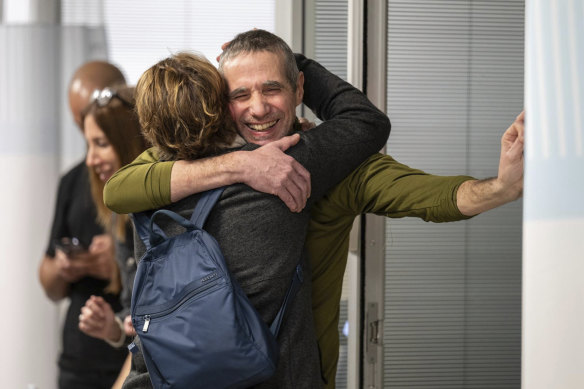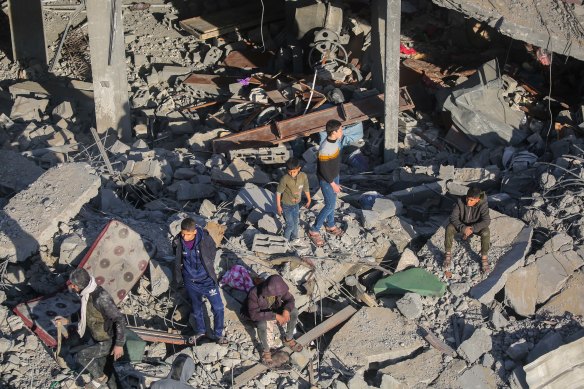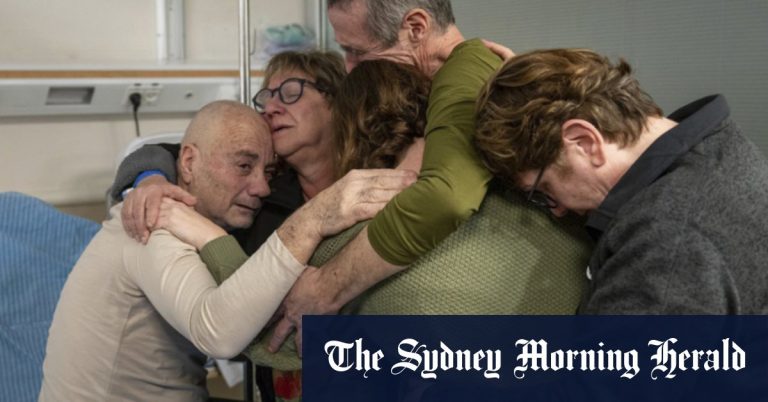The government has made the release of hostages a major goal of its war, along with destroying Hamas' military and governance capabilities. But as the fighting continued, divisions emerged in Israel over how to restore it.
Israel says about 100 hostages are still being held by Hamas after dozens were released during a ceasefire in November. Hamas also holds the remains of about 30 others who were killed on October 7 or died in captivity.

Hostage Fernando Simón Marman hugs a relative after being rescued.credit: the Israeli Defense Army
Netanyahu says continued military pressure will lead to the release of the prisoners even as the hostages' families and many of their supporters have called on the government to make another deal with Hamas.
The Israeli attack led to the killing of more than 28,000 Palestinians in the Gaza Strip, the displacement of more than 80% of the population, and caused a huge humanitarian crisis.
The Gaza Ministry of Health said that more than 12,300 Palestinian children and teenagers were killed in the conflict. Among the dead were about 8,400 women. This means that children and teenagers make up about 43% of the dead, and women and minors together make up three-quarters.
The ministry, which does not distinguish between combatants and civilians, provided the details at the request of the Associated Press. Israel claims to have killed about 10,000 Hamas fighters, but has not provided evidence.

Citizens inspect the damage to their homes after Israeli air strikes on Rafah, Gaza.credit: Getty Images
In a cross-border raid by Hamas on October 7, an estimated 1,200 people were killed, most of them civilians, and the militants captured 250 people, according to Israeli authorities.
Israel described Rafah as the last remaining stronghold of Hamas in the Gaza Strip and indicated that its ground attack may soon target the town located on the southern end of the Gaza Strip.
Airstrikes hit the crowded city of Rafah in the middle of the night, and dozens of explosions were heard around 2 a.m. Monday (11 a.m. EDT). Ashraf Al-Qudra, spokesman for the Ministry of Health, said that at least 67 people, including women and children, were killed in the raids.
Al-Qudra said that rescuers were still searching through the rubble. An Associated Press journalist counted at least 50 bodies at Abu Youssef al-Najjar Hospital in Rafah.
Muhammad Zagreb, a Palestinian living in Rafah, said he saw a black jeep speeding through the town, followed by clashes and intense air strikes.
Speaking from the bombed area, he said: “We found ourselves running with our children from air strikes in every direction.”
download
Footage circulated on social media from the Kuwaiti Rafah Hospital showed dead or wounded children. The footage could not immediately be verified but was consistent with AP reporting.
A young man was seen carrying the body of an infant who he said was killed in the attacks. He said that the girl, his neighbor's daughter, was born and killed during the war.
“Let Netanyahu come and see: Is this one of your specific goals?” He said.

